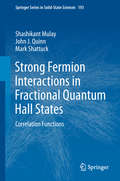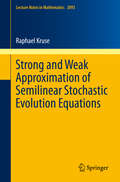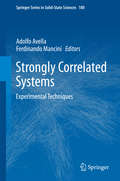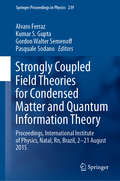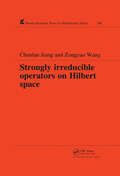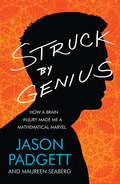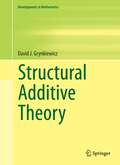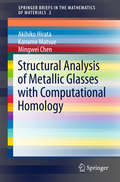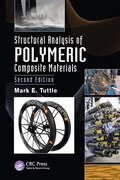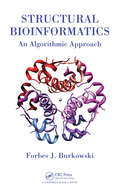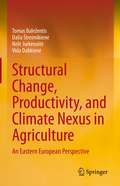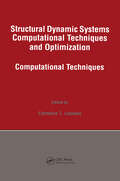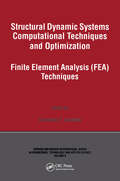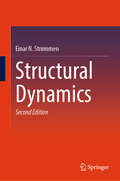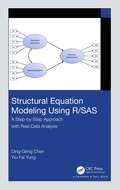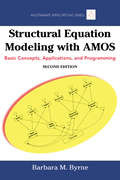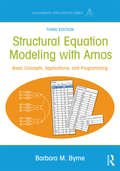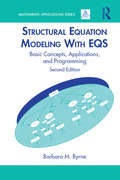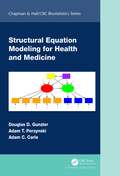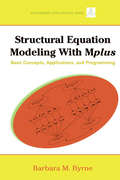- Table View
- List View
Strong Fermion Interactions in Fractional Quantum Hall States: Correlation Functions (Springer Series In Solid-state Sciences Ser. #193)
by John J. Quinn Shashikant Mulay Mark ShattuckThis monograph presents an intuitive theory of trial wave functions for strongly interacting fermions in fractional quantum Hall states. The correlation functions for the proposed fermion interactions follow a novel algebraic approach that harnesses the classical theory of invariants and semi-invariants of binary forms. This approach can be viewed as a fitting and far-reaching generalization of Laughlin’s approach to trial wave functions. Aesthetically viewed, it illustrates an attractive symbiosis between the theory of invariants and the theory of correlations. Early research into numerical diagonalization computations for small numbers of electrons shows strong agreement with the constructed trial wave functions.The monograph offers researchers and students of condensed matter physics an accessible discussion of this interesting area of research.
Strong and Weak Approximation of Semilinear Stochastic Evolution Equations
by Raphael KruseIn this book we analyze the error caused by numerical schemes for the approximation of semilinear stochastic evolution equations (SEEq) in a Hilbert space-valued setting. The numerical schemes considered combine Galerkin finite element methods with Euler-type temporal approximations. Starting from a precise analysis of the spatio-temporal regularity of the mild solution to the SEEq, we derive and prove optimal error estimates of the strong error of convergence in the first part of the book. The second part deals with a new approach to the so-called weak error of convergence, which measures the distance between the law of the numerical solution and the law of the exact solution. This approach is based on Bismut's integration by parts formula and the Malliavin calculus for infinite dimensional stochastic processes. These techniques are developed and explained in a separate chapter, before the weak convergence is proven for linear SEEq.
Strongly Correlated Systems
by Ferdinando Mancini Adolfo AvellaThis volume presents, for the very first time, an exhaustive collection of those modern numerical methods specifically tailored for the analysis of Strongly Correlated Systems. Many novel materials, with functional properties emerging from macroscopic quantum behaviors at the frontier of modern research in physics, chemistry and material science, belong to this class of systems. Any technique is presented in great detail by its own inventor or by one of the world-wide recognized main contributors. The exposition has a clear pedagogical cut and fully reports on the most relevant case study where the specific technique showed to be very successful in describing and enlightening the puzzling physics of a particular strongly correlated system. The book is intended for advanced graduate students and post-docs in the field as textbook and/or main reference, but also for other researchers in the field who appreciate consulting a single, but comprehensive, source or wishes to get acquainted, in a as painless as possible way, with the working details of a specific technique.
Strongly Coupled Field Theories for Condensed Matter and Quantum Information Theory: Proceedings, International Institute of Physics, Natal, Rn, Brazil, 2–21 August 2015 (Springer Proceedings in Physics #239)
by Alvaro Ferraz Kumar S. Gupta Gordon Walter Semenoff Pasquale SodanoThis book presents a selection of advanced lectures from leading researchers, providing recent theoretical results on strongly coupled quantum field theories. It also analyzes their use for describing new quantum states, which are physically realizable in condensed matter, cold-atomic systems, as well as artificial materials. It particularly focuses on the engineering of these states in quantum devices and novel materials useful for quantum information processing. The book offers graduate students and young researchers in the field of modern condensed matter theory an updated review of the most relevant theoretical methods used in strongly coupled field theory and string theory. It also provides the tools for understanding their relevance in describing the emergence of new quantum states in a variety of physical settings. Specifically, this proceedings book summarizes new and previously unrelated developments in modern condensed matter physics, in particular: the interface of condensed matter theory and quantum information theory; the interface of condensed matter physics and the mathematics emerging from the classification of the topological phases of matter, such as topological insulators and topological superconductors; and the simulation of condensed matter systems with cold atoms in optical lattices.
Strongly Irreducible Operators on Hilbert Space
by ChunLan JiangThis volume provides a comprehensive treatment of strongly irreducible operators acting on a complex separable infinite dimensional Hilbert space, and to expose and reflect the internal structure of operators by analyzing and studying irreducibility of operators. Much of the material presented here appears in book form for the first time.
Struck by Genius: How a Brain Injury Made Me a Mathematical Marvel
by Jason Padgett Maureen SeabergJason Padgett was an ordinary, not terribly bright, 41-year-old working in his father's furniture shop when he was the victim of a brutal mugging outside a karaoke bar in 2002.That same night his stepfather died of cancer, and two weeks later his only brother went missing (his body was discovered three year later). The combined traumas of these three events proved, unsurprisingly, too much for Jason and he withdrew from life completely, living as a hermit for four years suffering with agoraphobia and the onset of OCD. During this time he developed a fascination with the principles of the physical universe, devouring mathematics and physics journals. He also started to see intricate webs of shapes in his head and discovered that he could draw these by hand.A chance encounter in a mall pointed him in the direction of college. There, his extraordinary mind was recognised, and he was set on a path in which his drawings were identified as mathematical fractals and neuroscientists were able to diagnose a unique individual.Jason is a miraculous everyman with an inspiring 'what if' story that pushes beyond the boundaries of what scientists thought possible.
Structural Additive Theory
by David J. GrynkiewiczNestled between number theory, combinatorics, algebra and analysis lies a rapidly developing subject in mathematics variously known as additive combinatorics, additive number theory, additive group theory, and combinatorial number theory. Its main objects of study are not abelian groups themselves, but rather the additive structure of subsets and subsequences of an abelian group, i.e., sumsets and subsequence sums. This text is a hybrid of a research monograph and an introductory graduate textbook. With few exceptions, all results presented are self-contained, written in great detail, and only reliant upon material covered in an advanced undergraduate curriculum supplemented with some additional Algebra, rendering this book usable as an entry-level text. However, it will perhaps be of even more interest to researchers already in the field. The majority of material is not found in book form and includes many new results as well. Even classical results, when included, are given in greater generality or using new proof variations. The text has a particular focus on results of a more exact and precise nature, results with strong hypotheses and yet stronger conclusions, and on fundamental aspects of the theory. Also included are intricate results often neglected in other texts owing to their complexity. Highlights include an extensive treatment of Freiman Homomorphisms and the Universal Ambient Group of sumsets A+B, an entire chapter devoted to Hamidoune's Isoperimetric Method, a novel generalization allowing infinite summands in finite sumset questions, weighted zero-sum problems treated in the general context of viewing homomorphisms as weights, and simplified proofs of the Kemperman Structure Theorem and the Partition Theorem for setpartitions.
Structural Analysis of Metallic Glasses with Computational Homology
by Akihiko Hirata Kaname Matsue Mingwei ChenThis book introduces the application of computational homology for structural analysis of metallic glasses. Metallic glasses, relatively new materials in the field of metals, are the next-generation structural and functional materials owing to their excellent properties. To understand their properties and to develop novel metallic glass materials, it is necessary to uncover their atomic structures which have no periodicity, unlike crystals. Although many experimental and simulation studies have been performed to reveal the structures, it is extremely difficult to perceive a relationship between structures and properties without an appropriate point of view, or language. The purpose here is to show how a new approach using computational homology gives a useful insight into the interpretation of atomic structures. It is noted that computational homology has rapidly developed and is now widely applied for various data analyses. The book begins with a brief basic survey of metallic glasses and computational homology, then goes on to the detailed procedures and interpretation of computational homology analysis for metallic glasses. Understandable and readable information for both materials scientists and mathematicians is also provided.
Structural Analysis of Polymeric Composite Materials
by Mark E. TuttleStructural Analysis of Polymeric Composite Materials, Second Edition introduces the mechanics of composite materials and structures and combines classical lamination theory with macromechanical failure principles for prediction and optimization of composite structural performance. It addresses topics such as high-strength fibers, manufacturing tech
Structural Bioinformatics: An Algorithmic Approach (Chapman & Hall/CRC Computational Biology Series)
by Forbes J. BurkowskiThe Beauty of Protein Structures and the Mathematics behind Structural BioinformaticsProviding the framework for a one-semester undergraduate course, Structural Bioinformatics: An Algorithmic Approach shows how to apply key algorithms to solve problems related to macromolecular structure.Helps Students Go Further in Their Study of Structural Biolog
Structural Change, Productivity, and Climate Nexus in Agriculture: An Eastern European Perspective
by Dalia Štreimikienė Tomas Baležentis Nelė Jurkėnaitė Vida DabkienėThis monograph addresses the methodological and empirical issues relevant for the development of sustainable agriculture, with a particular focus on Eastern Europe. It relates economic growth to the other dimensions of sustainability by applying integrated methods. The book comprises five chapters dedicated to the theoretical approaches towards sustainable rural development, productivity analysis, structural change analysis and environmental footprint. The book focuses on the transformations of the agricultural sector while taking into account economic, environmental, and social dynamics. The importance of agricultural transformations to the livelihood of the rural population and food security are highlighted. Further, advanced methodologies and frameworks are presented to fathom the underlying trends in different facets of agricultural production. The authors present statistical methods used for the analysis of agricultural sustainability along with applications for agriculture in the European Union. Additionally, they discuss the measures of efficiency, methodological approaches and empirical models. Finally, the book applies econometric and optimization techniques, which are useful for the estimation of the production functions and other representations of technology in the case of the European Union member states. Therefore, the book is a must-read for researchers and students of agricultural and production economics, as well as policy-makers and academia in general.
Structural Dynamic Systems Computational Techniques and Optimization: Computational Techniques (Gordon and Breach International Series in Engineering, Technolo)
by Cornelius T. LeondesComputational techniques for the analysis and design of structural dynamic systems using numerical methods have been the focus of an enormous amount of research for several decades. In general, the numerical methods utilized to solve these problems include two phases: (a) spatial discretization by either the finite element method (FEM) or the finite difference method (FDM), and (b) solution of systems of time dependent second-order ordinary differential equations. In addition, the significantly powerful advances in computer systems capabilities have put on the desks of structural systems designers enormous computing power either by means of increasingly effective computer workstations or else through PCs (personal computers), whose increasing power has succeeded in marginalizing the computational power differences between PCs and workstations in many cases. This volume is a comprehensive treatment of the issues involved in computational techniques in structural dynamic systems.
Structural Dynamic Systems Computational Techniques and Optimization: Finite Element Analysis Techniques (Gordon And Breach International Series In Engineering, Technolo Ser.)
by Cornelius T. LeondesThe finite element, an approximation method for solving differential equations of mathematical physics, is a highly effective technique in the analysis and design, or synthesis, of structural dynamic systems. Starting from the system differential equations and its boundary conditions, what is referred to as a weak form of the problem (elaborated in the text) is developed in a variational sense. This variational statement is used to define elemental properties that may be written as matrices and vectors as well as to identify primary and secondary boundaries and all possible boundary conditions. Specific equilibrium problems are also solved. This book clearly reveals the effectiveness and great significance of the finite element method available and the essential role it will play in the future as further development occurs.
Structural Dynamics
by Einar N. StrømmenThe first part of this book covers the general theory of structural dynamics, in a calculous format as well as a finite element formulation. Secondly, it contains methods of eigenvalue calculations of civil engineering structural systems. And third, it contains a major part covering dynamic displacement response calculations as induced by earthquake, turbulent wind, vortex shedding and moving vehicles, enabling the designer to evaluate structural safety from the effects of fluctuating internal forces.The general theory contains comprehensive development of the principle of virtual displacements, as well as the Galerkin solution to eigenvalue problems. A separate chapter has been dedicated to the suspension bridge. The theory of single or multiple tuned mass dampers is included, a theory not presented elsewhere.The book contains a chapter covering the theory of structural damping, as well as comprehensive data of the structural damping properties that are necessary forany dynamic response calculation. The book is intended for students as well as practising engineers. It contains numerous relevant examples, covering numerical solutions that are well suited for computer programming.
Structural Equation Modeling Using R/SAS: A Step-by-Step Approach with Real Data Analysis
by Ding-Geng Chen Yiu-Fai YungThere has been considerable attention to making the methodologies of structural equation modeling available to researchers, practitioners, and students along with commonly used software. Structural Equation Modelling Using R/SAS aims to bring it all together to provide a concise point-of-reference for the most commonly used structural equation modeling from the fundamental level to the advanced level. This book is intended to contribute to the rapid development in structural equation modeling and its applications to real-world data. Straightforward explanations of the statistical theory and models related to structural equation models are provided, using a compilation of a variety of publicly available data, to provide an illustration of data analytics in a step-by-step fashion using commonly used statistical software of R and SAS. This book is appropriate for anyone who is interested in learning and practicing structural equation modeling, especially in using R and SAS. It is useful for applied statisticians, data scientists and practitioners, applied statistical analysts and scientists in public health, and academic researchers and graduate students in statistics, whilst also being of use to R&D professionals/practitioners in industry and governmental agencies. Key Features: Extensive compilation of commonly used structural equation models and methods from fundamental to advanced levels Straightforward explanations of the theory related to the structural equation models Compilation of a variety of publicly available data Step-by-step illustrations of data analysis using commonly used statistical software R and SAS Data and computer programs are available for readers to replicate and implement the new methods to better understand the book contents and for future applications Handbook for applied statisticians and practitioners
Structural Equation Modeling With AMOS: Basic Concepts, Applications, and Programming, Second Edition
by Barbara M. ByrneThis bestselling text provides a practical guide to the basic concepts of structural equation modeling (SEM) and the AMOS program (Versions 17 & 18). The author reviews SEM applications based on actual data taken from her research. Noted for its non-mathematical language, this book is written for the novice SEM user. With each chapter, the author "walks" the reader through all steps involved in testing the SEM model including: an explanation of the issues addressed an illustration of the hypothesized and posthoc models tested AMOS input and output with accompanying interpretation and explanation The function of the AMOS toolbar icons and their related pull-down menus The data and published reference upon which the model was based. With over 50% new material, highlights of the new edition include: All new screen shots featuring Version 17 of the AMOS program All data files now available at www.routledge.com/9780805863734 Application of a multitrait-mulitimethod model, latent growth curve model, and second-order model based on categorical data All applications based on the most commonly used graphical interface The automated multi-group approach to testing for equivalence The book opens with an introduction to the fundamental concepts of SEM and the basics of the AMOS program. The next 3 sections present applications that focus on single-group, multiple-group, and multitrait-mutimethod and latent growth curve models. The book concludes with a discussion about non-normal and missing (incomplete) data and two applications capable of addressing these issues. Intended for researchers, practitioners, and students who use SEM and AMOS in their work, this book is an ideal resource for graduate level courses on SEM taught in departments of psychology, education, business, and other social and health sciences and/or as a supplement in courses on applied statistics, multivariate statistics, statistics II, intermediate or advanced statistics, and/or research design. Appropriate for those with limited or no previous exposure to SEM, a prerequisite of basic statistics through regression analysis is recommended.
Structural Equation Modeling With AMOS: Basic Concepts, Applications, and Programming, Third Edition (Multivariate Applications Series)
by Barbara M. ByrneThis bestselling text provides a practical guide to structural equation modeling (SEM) using the Amos Graphical approach. Using clear, everyday language, the text is ideal for those with little to no exposure to either SEM or Amos. The author reviews SEM applications based on actual data taken from her own research. Each chapter "walks" readers through the steps involved (specification, estimation, evaluation, and post hoc modification) in testing a variety of SEM models. Accompanying each application is: an explanation of the issues addressed and a schematic presentation of hypothesized model structure; Amos? input and output with interpretations; use of the Amos toolbar icons and pull-down menus; and data upon which the model application was based, together with updated references pertinent to the SEM model? tested. Thoroughly updated throughout, the new edition features: All new screen shots featuring Amos Version 23.?? Descriptions and illustrations of Amos’ new Tables View format which enables the specification of a structural model in spreadsheet form.???? Key concepts and/or techniques that introduce each chapter. Alternative approaches to model analyses when enabled by Amos thereby allowing users to determine the method best suited to their data.? Provides analysis of the same model based on continuous and categorical data (Ch. 5) thereby enabling readers to observe two ways of specifying and testing the same model as well as compare results. All applications based on the Amos graphical mode interface accompanied by more "how to" coverage of graphical techniques unique to Amos. More explanation of key procedures and analyses that address questions posed by readers All application data files are available at www.routledge.com/9781138797031. The two introductory chapters in Section 1 review the fundamental concepts of SEM methodology and a general overview of the Amos program. Section 2 provides single-group analyses applications including two first-order confirmatory factor analytic (CFA) models, one second-order CFA model, and one full latent variable model. Section 3 presents multiple-group analyses applications with two rooted in the analysis of covariance structures and one in the analysis of mean and covariance structures. Two models that are increasingly popular with SEM practitioners, construct validity and testing change over time using the latent growth curve, are presented in Section 4. The book concludes with a review of the use of bootstrapping to address non-normal data and a review of missing (or incomplete) data in Section 5. An ideal supplement for graduate level courses in psychology, education, business, and social and health sciences that cover the fundamentals of SEM with a focus on Amos, this practical text continues to be a favorite of both researchers and practitioners. A prerequisite of basic statistics through regression analysis is recommended but no exposure to either SEM or Amos is required.
Structural Equation Modeling With EQS: Basic Concepts, Applications, and Programming, Second Edition (Multivariate Applications Series)
by Barbara M. ByrneReaders who want a less mathematical alternative to the EQS manual will find exactly what they're looking for in this practical text. Written specifically for those with little to no knowledge of structural equation modeling (SEM) or EQS, the author's goal is to provide a non-mathematical introduction to the basic concepts of SEM by applying these principles to EQS, Version 6.1. The book clearly demonstrates a wide variety of SEM/EQS applications that include confirmatory factor analytic and full latent variable models. Written in a "user-friendly" style, the author "walks" the reader through the varied steps involved in the process of testing SEM models: model specification and estimation, assessment of model fit, EQS output, and interpretation of findings. Each of the book's applications is accompanied by: a statement of the hypothesis being tested, a schematic representation of the model, explanations of the EQS input and output files, tips on how to use the pull-down menus, and the data file upon which the application is based. The book carefully works through applications starting with relatively simple single group analyses, through to more advanced applications, such as a multi-group, latent growth curve, and multilevel modeling. The new edition features: many new applications that include a latent growth curve model, a multilevel model, a second-order model based on categorical data, a missing data multigroup model based on the EM algorithm, and the testing for latent mean differences related to a higher-order model; a CD enclosed with the book that includes all application data; vignettes illustrating procedural and/or data management tasks; and description of how to build models both interactively using the BUILD-EQ interface and graphically using the EQS Diagrammer.
Structural Equation Modeling for Health and Medicine (Chapman & Hall/CRC Biostatistics Series)
by Douglas D. Gunzler Adam T. Perzynski Adam C. CarleStructural equation modeling (SEM) is a very general and flexible multivariate technique that allows relationships among variables to be examined. The roots of SEM are in the social sciences. In writing this textbook, the authors look to make SEM accessible to a wider audience of researchers across many disciplines, addressing issues unique to health and medicine. SEM is often used in practice to model and test hypothesized causal relationships among observed and latent (unobserved) variables, including in analysis across time and groups. It can be viewed as the merging of a conceptual model, path diagram, confirmatory factor analysis, and path analysis. In this textbook the authors also discuss techniques, such as mixture modeling, that expand the capacity of SEM using a combination of both continuous and categorical latent variables. Features: Basic, intermediate, and advanced SEM topics Detailed applications, particularly relevant for health and medical scientists Topics and examples that are pertinent to both new and experienced SEM researchers Substantive issues in health and medicine in the context of SEM Both methodological and applied examples Numerous figures and diagrams to illustrate the examples As SEM experts situated among clinicians and multidisciplinary researchers in medical settings, the authors provide a broad, current, on the ground understanding of the issues faced by clinical and health services researchers and decision scientists. This book gives health and medical researchers the tools to apply SEM approaches to study complex relationships between clinical measurements, individual and community-level characteristics, and patient-reported scales.
Structural Equation Modeling with Mplus: Basic Concepts, Applications, and Programming (Multivariate Applications Series)
by Barbara M. ByrneModeled after Barbara Byrne’s other best-selling structural equation modeling (SEM) books, this practical guide reviews the basic concepts and applications of SEM using Mplus Versions 5 & 6. The author reviews SEM applications based on actual data taken from her own research. Using non-mathematical language, it is written for the novice SEM user. With each application chapter, the author "walks" the reader through all steps involved in testing the SEM model including: an explanation of the issues addressed illustrated and annotated testing of the hypothesized and post hoc models explanation and interpretation of all Mplus input and output files important caveats pertinent to the SEM application under study a description of the data and reference upon which the model was based the corresponding data and syntax files available at http://www.psypress.com/sem-with-mplus/datasets . The first two chapters introduce the fundamental concepts of SEM and important basics of the Mplus program. The remaining chapters focus on SEM applications and include a variety of SEM models presented within the context of three sections: Single-group analyses, Multiple-group analyses, and other important topics, the latter of which includes the multitrait-multimethod, latent growth curve, and multilevel models. Intended for researchers, practitioners, and students who use SEM and Mplus, this book is an ideal resource for graduate level courses on SEM taught in psychology, education, business, and other social and health sciences and/or as a supplement for courses on applied statistics, multivariate statistics, intermediate or advanced statistics, and/or research design. Appropriate for those with limited exposure to SEM or Mplus, a prerequisite of basic statistics through regression analysis is recommended.
Structural Equation Modeling: Applications Using Mplus
by Jichuan Wang Xiaoqian WangA reference guide for applications of SEM using Mplus Structural Equation Modeling: Applications Using Mplus is intended as both a teaching resource and a reference guide. <P><P>Written in non-mathematical terms, this book focuses on the conceptual and practical aspects of Structural Equation Modeling (SEM). Basic concepts and examples of various SEM models are demonstrated along with recently developed advanced methods, such as mixture modeling and model-based power analysis and sample size estimate for SEM. The statistical modeling program, Mplus, is also featured and provides researchers with a flexible tool to analyze their data with an easy-to-use interface and graphical displays of data and analysis results. <P>Key features: Presents a useful reference guide for applications of SEM whilst systematically demonstrating various advanced SEM models, such as multi-group and mixture models using Mplus. Discusses and demonstrates various SEM models using both cross-sectional and longitudinal data with both continuous and categorical outcomes. Provides step-by-step instructions of model specification and estimation, as well as detail interpretation of Mplus results. Explores different methods for sample size estimate and statistical power analysis for SEM. By following the examples provided in this book, readers will be able to build their own SEM models using Mplus. Teachers, graduate students, and researchers in social sciences and health studies will also benefit from this book.
Structural Equation Modeling: Applications Using Mplus (Wiley Series in Probability and Statistics #9)
by Jichuan Wang Xiaoqian WangPresents a useful guide for applications of SEM whilst systematically demonstrating various SEM models using Mplus Focusing on the conceptual and practical aspects of Structural Equation Modeling (SEM), this book demonstrates basic concepts and examples of various SEM models, along with updates on many advanced methods, including confirmatory factor analysis (CFA) with categorical items, bifactor model, Bayesian CFA model, item response theory (IRT) model, graded response model (GRM), multiple imputation (MI) of missing values, plausible values of latent variables, moderated mediation model, Bayesian SEM, latent growth modeling (LGM) with individually varying times of observations, dynamic structural equation modeling (DSEM), residual dynamic structural equation modeling (RDSEM), testing measurement invariance of instrument with categorical variables, longitudinal latent class analysis (LLCA), latent transition analysis (LTA), growth mixture modeling (GMM) with covariates and distal outcome, manual implementation of the BCH method and the three-step method for mixture modeling, Monte Carlo simulation power analysis for various SEM models, and estimate sample size for latent class analysis (LCA) model. The statistical modeling program Mplus Version 8.2 is featured with all models updated. It provides researchers with a flexible tool that allows them to analyze data with an easy-to-use interface and graphical displays of data and analysis results. Intended as both a teaching resource and a reference guide, and written in non-mathematical terms, Structural Equation Modeling: Applications Using Mplus, 2nd edition provides step-by-step instructions of model specification, estimation, evaluation, and modification. Chapters cover: Confirmatory Factor Analysis (CFA); Structural Equation Models (SEM); SEM for Longitudinal Data; Multi-Group Models; Mixture Models; and Power Analysis and Sample Size Estimate for SEM. Presents a useful reference guide for applications of SEM while systematically demonstrating various advanced SEM models Discusses and demonstrates various SEM models using both cross-sectional and longitudinal data with both continuous and categorical outcomes Provides step-by-step instructions of model specification and estimation, as well as detailed interpretation of Mplus results using real data sets Introduces different methods for sample size estimate and statistical power analysis for SEM Structural Equation Modeling is an excellent book for researchers and graduate students of SEM who want to understand the theory and learn how to build their own SEM models using Mplus.
Structural Equation Modelling with Partial Least Squares Using Stata and R
by Mehmet Mehmetoglu Sergio VenturiniPartial least squares structural equation modelling (PLS-SEM) is becoming a popular statistical framework in many fields and disciplines of the social sciences. The main reason for this popularity is that PLS-SEM can be used to estimate models including latent variables, observed variables, or a combination of these. The popularity of PLS-SEM is predicted to increase even more as a result of the development of new and more robust estimation approaches, such as consistent PLS-SEM. The traditional and modern estimation methods for PLS-SEM are now readily facilitated by both open-source and commercial software packages. This book presents PLS-SEM as a useful practical statistical toolbox that can be used for estimating many different types of research models. In so doing, the authors provide the necessary technical prerequisites and theoretical treatment of various aspects of PLS-SEM prior to practical applications. What makes the book unique is the fact that it thoroughly explains and extensively uses comprehensive Stata (plssem) and R (cSEM and plspm) packages for carrying out PLS-SEM analysis. The book aims to help the reader understand the mechanics behind PLS-SEM as well as performing it for publication purposes. Features: Intuitive and technical explanations of PLS-SEM methods Complete explanations of Stata and R packages Lots of example applications of the methodology Detailed interpretation of software output Reporting of a PLS-SEM study Github repository for supplementary book material The book is primarily aimed at researchers and graduate students from statistics, social science, psychology, and other disciplines. Technical details have been moved from the main body of the text into appendices, but it would be useful if the reader has a solid background in linear regression analysis.
Structural Equation Modelling: Application for Research and Practice (with AMOS and R) (Studies in Systems, Decision and Control #285)
by Jitesh J. ThakkarStructural Equation Modeling provides a conceptual and mathematical understanding of structural equation modelling, helping readers across disciplines understand how to test or validate theoretical models, and build relationships between observed variables. In addition to a providing a background understanding of the concepts, it provides step-by-step illustrative applications with AMOS, SPSS and R software programmes. This volume will serve as a useful reference for academic and industry researchers in the fields of engineering, management, psychology, sociology, human resources, and humanities.
Structural Equation Models: From Paths to Networks (Studies in Systems, Decision and Control #22)
by J. Christopher WestlandThis new edition surveys the full range of available structural equation modeling (SEM) methodologies. The book has been updated throughout to reflect the arrival of new software packages, which have made analysis much easier than in the past. Applications in a broad range of disciplines are discussed, particularly in the social sciences where many key concepts are not directly observable. This book presents SEM’s development in its proper historical context–essential to understanding the application, strengths and weaknesses of each particular method. This book also surveys the emerging path and network approaches that complement and enhance SEM, and that are growing in importance. SEM’s ability to accommodate unobservable theory constructs through latent variables is of significant importance to social scientists. Latent variable theory and application are comprehensively explained and methods are presented for extending their power, including guidelines for data preparation, sample size calculation and the special treatment of Likert scale data. Tables of software, methodologies and fit statistics provide a concise reference for any research program, helping assure that its conclusions are defensible and publishable.
